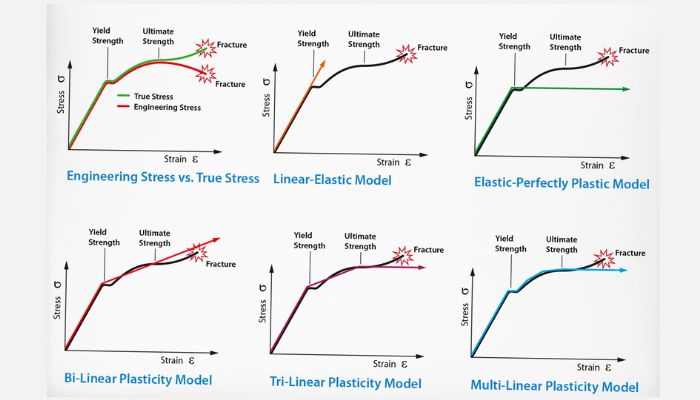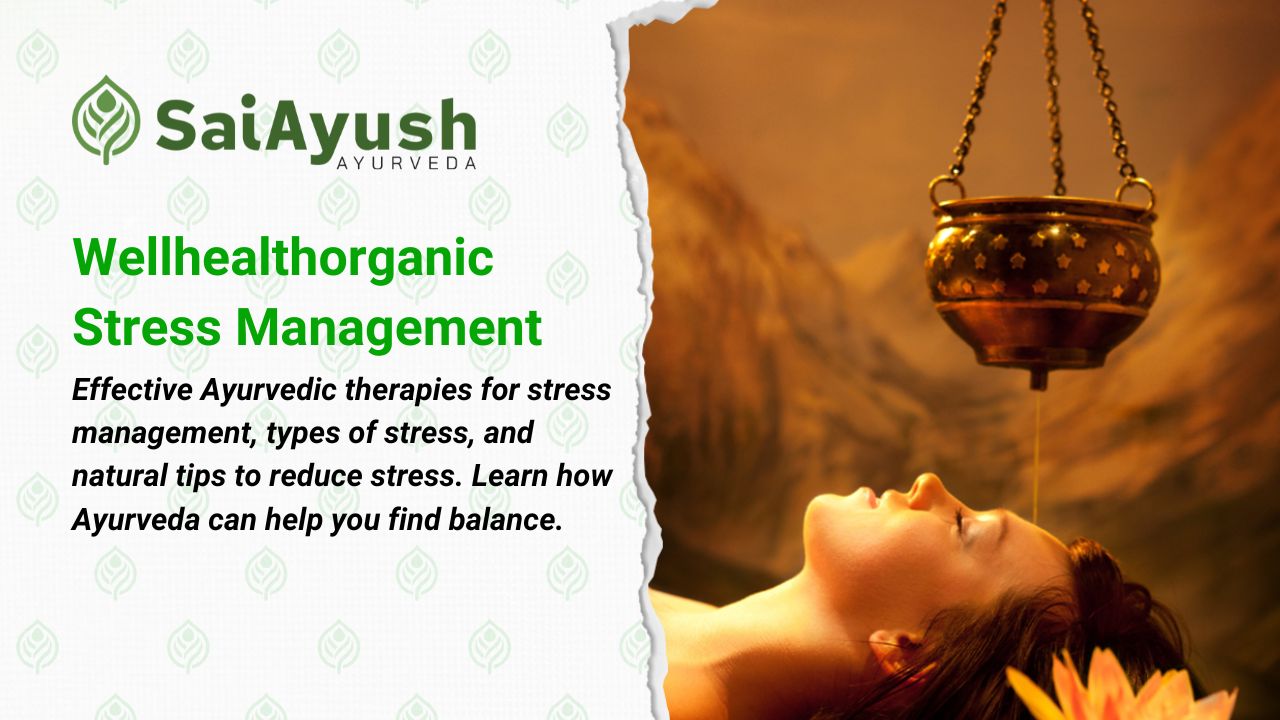Stress is a common challenge in today’s fast-paced world, impacting our physical and mental well-being. At Sai Ayush Ayurveda Hospitals, we believe in a holistic approach to managing stress through Ayurveda, an ancient system of medicine that emphasizes natural healing and balance.
Types of Stress
- Acute Stress: Short-term stress that arises from immediate challenges or threats. Examples include deadlines and minor accidents.
- Chronic Stress: Long-term stress that results from ongoing issues such as financial problems, relationship difficulties, or job dissatisfaction.
- Eustress: Positive stress that can motivate and inspire, such as the excitement of starting a new project or activity.
Stress strain curve
The stress-strain curve is a graphical representation of the relationship between the stress (force per unit area) applied to a material and the strain (deformation or elongation) that results. It helps in understanding how materials behave under different types of loading conditions.
Key Components of the Curve:
- Stress (σ):
- Definition: Stress is the force applied per unit area of a material.
- Formula: Stress = Force / Area (σ = F / A)
- Units: Typically measured in Pascals (Pa) or Newtons per square meter (N/m²).
- Strain (ε):
- Definition: Strain is the amount of deformation experienced by a material compared to its original length.
- Formula: Strain = Change in Length / Original Length (ε = ΔL / L₀)
- Units: It is a dimensionless quantity (expressed as a ratio or percentage).
Typical Stages of the Stress-Strain Curve:
- Elastic Region:
- Description: The initial, linear portion of the curve where the material deforms elastically. In this region, stress and strain are directly proportional.
- Key Point: Elastic Limit – The maximum stress that can be applied without causing permanent deformation.
- Modulus of Elasticity (E): The slope of the linear portion, representing the material’s stiffness. It’s calculated as E = Stress / Strain.
- Yield Point:
- Description: The point at which the material begins to deform plastically. It marks the end of the elastic region.
- Key Point: Yield Strength – The stress at which noticeable plastic deformation occurs.
- Plastic Region:
- Description: Beyond the yield point, where the material deforms permanently. The curve may become non-linear, showing the material’s ability to withstand higher stress without immediate failure.
- Key Point: Plastic Deformation – Permanent changes in the shape of the material.
- Ultimate Tensile Strength (UTS):
- Description: The maximum stress that the material can withstand before it starts to neck or thin out.
- Key Point: Tensile Strength – The peak of the curve, indicating the greatest stress the material can handle.
- Fracture Point:
- Description: The point at which the material breaks or fractures.
- Key Point: Breaking Strength – The stress level at which the material ultimately fails.
Types of Stress-Strain Curves:
- Ductile Materials:
- Characteristics: Show a significant plastic region and undergo considerable deformation before breaking (e.g., steel, aluminum).
- Curve Appearance: Exhibit a distinct yield point and a long, gradual curve before fracture.
- Brittle Materials:
- Characteristics: Have little to no plastic deformation and fracture suddenly after reaching their ultimate strength (e.g., glass, ceramics).
- Curve Appearance: Show a short, linear elastic region followed by a sudden drop to fracture.
Applications of the Stress-Strain Curve:
- Material Selection: Helps engineers choose appropriate materials based on their mechanical properties.
- Design and Safety: Ensures that structures and components can withstand expected loads without failing.
- Quality Control: Used to assess the consistency and quality of materials in manufacturing.
Understanding the stress-strain curve is essential for predicting material behavior under load and ensuring the safety and reliability of engineering designs.

stress strain curve
How to reduce stress
Lifestyle Changes: Incorporate relaxation techniques, exercise, and balanced nutrition into your daily routine.
Mindfulness Practices: Engage in meditation, yoga, and deep-breathing exercises.
Therapeutic Treatments: Explore Ayurvedic therapies designed to alleviate stress and restore balance.
Stress management
Ayurveda offers a range of therapies to manage and reduce stress effectively. Research supports the effectiveness of these treatments in promoting mental clarity and physical well-being.
Ayurvedic Therapies for Stress Management
Shirodhara
Shirodhara is a traditional Ayurvedic therapy that involves gently pouring warm herbal oil or other medicated liquids onto the forehead in a continuous stream. The word “Shirodhara” comes from Sanskrit, where “Shiro” means “head” and “Dhara” means “flow.”
- Mental Clarity: Helps in calming the mind, reducing anxiety, and enhancing mental clarity.
- Stress Relief: Alleviates stress and promotes relaxation.
- Improved Sleep: Aids in improving sleep quality by soothing the nervous system.
- Balancing Doshas: Helps in balancing the Vata and Pitta doshas (body energies) in Ayurveda.
- Enhances Mood: Can help improve mood and overall emotional well-being.
Procedure:
- Preparation: The patient lies down on a treatment table with their head positioned comfortably. A specially designed apparatus is used to ensure a continuous stream of oil.
- Application: Warm, medicated oil is poured in a steady, rhythmic stream onto the forehead, particularly targeting the “Ajna” or “third eye” area.
- Duration: The session typically lasts 30 to 60 minutes.
- Post-Treatment: Patients are advised to rest and avoid exposure to cold or strenuous activities immediately after the treatment.
Shirodhara is particularly beneficial for individuals experiencing stress, anxiety, insomnia, and mental fatigue.
Abhyanga
Abhyanga is an Ayurvedic therapeutic massage involving the application of warm, herbal oils to the entire body. “Abhyanga” means “massage” in Sanskrit, and this treatment is a cornerstone of Ayurvedic practice.
- Deep Relaxation: Promotes deep relaxation and reduces stress by soothing the nervous system.
- Improves Circulation: Enhances blood circulation and lymphatic flow.
- Detoxification: Helps in eliminating toxins from the body and supports the natural detoxification process.
- Nourishes Skin: Moisturizes and nourishes the skin, improving its texture and appearance.
- Balances Doshas: Balances the body’s doshas (Vata, Pitta, and Kapha), leading to overall harmony and well-being.
Procedure:
- Preparation: The patient is usually asked to undress and lie down on a treatment table. Warm, medicated oil is chosen based on individual dosha and health needs.
- Application: The therapist applies warm oil to the body using long, flowing strokes. The massage is typically performed with rhythmic pressure and varies in technique depending on the therapeutic goal.
- Duration: A typical Abhyanga session lasts between 45 to 90 minutes.
- Post-Treatment: After the massage, the oil is usually left on the body for some time to allow for deep absorption, followed by a warm bath or shower to remove excess oil.
Abhyanga is beneficial for individuals seeking stress relief, improved circulation, and overall rejuvenation. It is often recommended for those with dry skin, chronic fatigue, or imbalanced doshas.
Both Shirodhara and Abhyanga are integral parts of Ayurvedic wellness practices, offering holistic benefits that address both physical and mental health.
Panchakarma: A detoxification process that includes various treatments to cleanse the body and reduce stress.
Yoga and Meditation: Regular practice can help in balancing the doshas (body energies) and improving overall mental health.
Herbal Remedies: Use of herbs such as Ashwagandha and Brahmi to support the body’s stress response.
Ayurveda Natural Tips for Stress
- Daily Routine: Establish a consistent daily routine to stabilize the body’s rhythms.
- Dietary Adjustments: Eat a balanced diet rich in fresh fruits, vegetables, and whole grains to support overall health.
- Hydration: Drink plenty of water to keep your body hydrated and help manage stress levels.
FAQs
Q:What are the best Ayurvedic therapies for stress management?
Ayurvedic therapies such as Abhyanga, Shirodhara, and Panchakarma are highly effective in managing stress. They work by calming the nervous system and promoting overall relaxation.
Q:How does Ayurveda help in reducing stress?
Ayurveda helps in reducing stress by restoring balance in the body and mind through natural therapies, dietary changes, and lifestyle adjustments.
Q:What are some natural tips for stress management according to Ayurveda?
Natural tips include maintaining a consistent daily routine, consuming a balanced diet, staying hydrated, and incorporating relaxation practices like yoga and meditation.
Q:Can Ayurvedic therapies be combined with conventional treatments for stress?
Yes, Ayurvedic therapies can complement conventional treatments. It’s essential to consult with both Ayurvedic practitioners and healthcare providers for a comprehensive approach.
Q:How often should I undergo Ayurvedic stress management treatments?
The frequency of treatments depends on individual needs. Regular sessions may be recommended initially, with follow-up treatments as needed based on your response and lifestyle.
Discover the healing power of Ayurveda with our latest article at Sai Ayush Ayurveda Hospitals! Dive into the age-old wisdom that can rejuvenate your body and mind. Click here to read more:



0 Comments